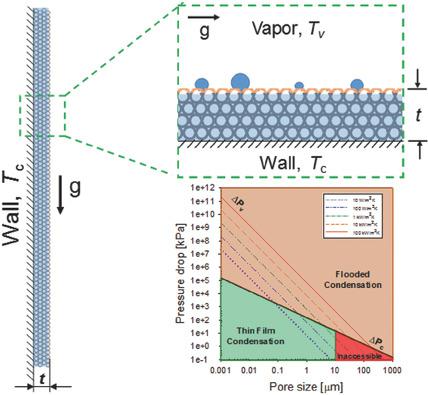当前位置:
X-MOL 学术
›
Adv. Funct. Mater.
›
论文详情
Our official English website, www.x-mol.net, welcomes your
feedback! (Note: you will need to create a separate account there.)
Thin Film Condensation on Nanostructured Surfaces
Advanced Functional Materials ( IF 18.5 ) Pub Date : 2018-02-15 , DOI: 10.1002/adfm.201707000 Junho Oh 1, 2 , Runyu Zhang 3, 4, 5 , Pralav P. Shetty 3, 4 , Jessica A. Krogstad 3, 4 , Paul V. Braun 3, 4, 5 , Nenad Miljkovic 1, 2, 3
Advanced Functional Materials ( IF 18.5 ) Pub Date : 2018-02-15 , DOI: 10.1002/adfm.201707000 Junho Oh 1, 2 , Runyu Zhang 3, 4, 5 , Pralav P. Shetty 3, 4 , Jessica A. Krogstad 3, 4 , Paul V. Braun 3, 4, 5 , Nenad Miljkovic 1, 2, 3
Affiliation

|
Water vapor condensation is a ubiquitous process in nature and industry. Over the past century, methods achieving dropwise condensation using a thin (<1 µm) hydrophobic “promoter” layer have been developed, which increases the condensation heat transfer by ten times compared to filmwise condensation. Unfortunately, implementations of dropwise condensation have been limited due to poor durability of the promoter coatings. Here, thin‐film condensation which utilizes a promoter layer not as a condensation surface, but rather to confine the condensate within a porous biphilic nanostructure, nickel inverse opals (NIO) with a thin (<20 nm) hydrophobic top layer of decomposed polyimide is developed. Filmwise condensation confined to thicknesses <10 µm is demonstrated. To test the stability of thin‐film condensation, condensation experiments are performed to show that at higher supersaturations droplets coalescing on top of the hydrophobic layer are absorbed into the superhydrophilic layer through coalescence‐induced transitions. Through detailed thermal‐hydrodynamic modeling, it is shown that thin‐film condensation has the potential to achieve heat transfer coefficients approaching ≈100 kW m−2 while avoiding durability issues by significantly reducing nucleation on the hydrophobic surface. The work presented here develops an approach to potentially ensure durable and high‐performance condensation comparable to dropwise condensation.
中文翻译:

纳米结构表面上的薄膜凝结
水蒸气冷凝是自然界和工业界普遍存在的过程。在过去的一个世纪中,已经开发出使用薄的(<1 µm)疏水性“促进剂”层实现逐滴冷凝的方法,该方法与膜式冷凝相比,将冷凝传热提高了十倍。不幸的是,由于促进剂涂层的耐久性差,逐滴冷凝的实施受到了限制。在这里,薄膜缩合不是利用促进剂层作为缩合表面,而是将缩合物限制在多孔双亲纳米结构中,镍反蛋白石(NIO)带有一层薄的(<20 nm)疏水性聚酰亚胺分解顶层。发达。膜状冷凝水的厚度限制在10 µm以内。为了测试薄膜冷凝的稳定性,冷凝实验表明,在较高的过饱和度时,疏水层顶部聚结的液滴通过聚结诱导的过渡被吸收到超亲水层中。通过详细的热流体动力学建模,表明薄膜冷凝有可能实现接近≈100kW m的传热系数−2同时通过显着减少疏水性表面上的成核现象避免了耐久性问题。此处介绍的工作开发了一种方法,可以潜在地确保与逐滴凝结相当的持久且高性能的凝结。
更新日期:2018-02-15
中文翻译:

纳米结构表面上的薄膜凝结
水蒸气冷凝是自然界和工业界普遍存在的过程。在过去的一个世纪中,已经开发出使用薄的(<1 µm)疏水性“促进剂”层实现逐滴冷凝的方法,该方法与膜式冷凝相比,将冷凝传热提高了十倍。不幸的是,由于促进剂涂层的耐久性差,逐滴冷凝的实施受到了限制。在这里,薄膜缩合不是利用促进剂层作为缩合表面,而是将缩合物限制在多孔双亲纳米结构中,镍反蛋白石(NIO)带有一层薄的(<20 nm)疏水性聚酰亚胺分解顶层。发达。膜状冷凝水的厚度限制在10 µm以内。为了测试薄膜冷凝的稳定性,冷凝实验表明,在较高的过饱和度时,疏水层顶部聚结的液滴通过聚结诱导的过渡被吸收到超亲水层中。通过详细的热流体动力学建模,表明薄膜冷凝有可能实现接近≈100kW m的传热系数−2同时通过显着减少疏水性表面上的成核现象避免了耐久性问题。此处介绍的工作开发了一种方法,可以潜在地确保与逐滴凝结相当的持久且高性能的凝结。











































 京公网安备 11010802027423号
京公网安备 11010802027423号